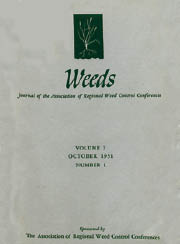Article contents
Relation of Stomatal Penetration to Herbicidal Effects Using Fluorescent Dye as a Tracer
Published online by Cambridge University Press: 12 June 2017
Abstract
Plants of Zebrina pendula L., Phaseolus vulgaris L., Sorghum halepense (L.) Pers., and Chenopodium album L. were sprayed with a solution containing herbicide (sodium 2,4-dichlorophenoxyacetic acid or sodium 2,2-dichloropropionic acid), surfactant (sodium dioctylsulfosuccinate), and fluorescent tracer (sodium pyrenetrisulfonate). In most instances plants having stomata relatively open absorbed more tracer (based on UV observation) and more herbicide (based on injury and growth responses) than those with stomata relatively closed. Differences, however, were less than those expected from studies using detached leaves, probably from poorer control of stomatal aperture in intact leaves. There was good agreement between degree of opening and tracer uptake.
- Type
- Research Article
- Information
- Copyright
- Copyright © 1964 Weed Science Society of America
References
Literature Cited
- 9
- Cited by


